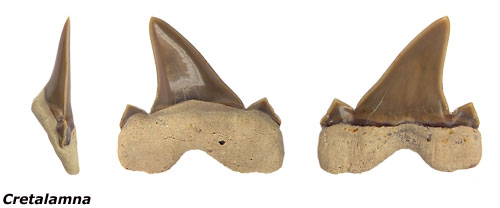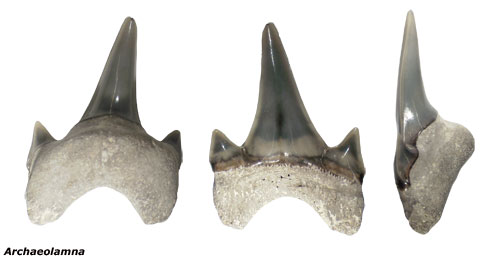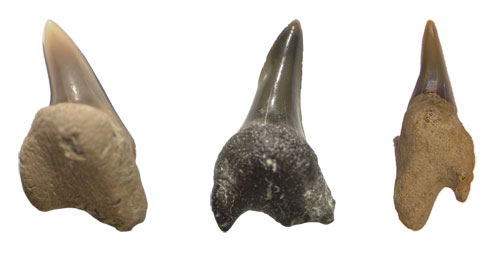During
the Cretaceous, neoselachians diversified rapidly (UNDERWOOD, 2006).
Particularly the middle part of the Cretaceous was a time of high diversity
and rapid rates of dental evolution in lamniform sharks (SIVERSON &
LINDGREN, 2005). However, the arrangement of these taxa into families
is far from understood and differs among researchers, especially between
morphological (e.g. COMPAGNO, 1990; SHIRAI, 1996; SHIMADA,
2005) and molecular studies (e.g. MARTIN & NAYLOR, 1997;
NAYLOR ET AL., 1997).
The
Cretoxyrhinidae sensu CAPPETTA (1987) included the Cretaceous
genera Cretalamna, Cretodus, Cretoxyrhina,
Leptostyrax, Paraisurus, Pseudoisurus and
Protolamna. SIVERSON (1992, 1996) tentatively accepted this
classification and added Archaeolamna to the Cretoxyrhinidae.
Later, SIVERSON (1999) considered Cretoxyrhinidae to be monotypic and
restricted it to Cretoxyrhina. Taxa, previously assigned to
Cretoxyrhinidae, should be placed into other suprageneric taxa. As only
skeletal material and associated dentitions can help in solving the
position of most fossil lamniforms (SIVERSON, 1999; KRIWET, 2006), some
genera previously included in the Cretoxyrhinidae are not yet attributed
to any nominal family. |
| |
| |
CRETOXYRHINIDAE
Glickman 1958 |
| Cretoxyrhina
mantelli (Agassiz, 1843) |
[Cenomanian-Turonian
& Campanian] |
| |
|
EOPTOLAMNIDAE
Kriwet, Klug, Canudo & Cuenca-Bescos 2008 |
| Protolamna
borodini (Cappetta & Case 1975) |
[Campanian
& Maastrichtian] |
| Protolamna
compressidens (Herman, 1977)
|
[Cenomanian-Turonian] |
| Protolamna
sp. |
[Albian] |
| |
|
OTODONTIDAE
Glickman 1964 |
| Cretalamna
appendiculata
(Agassiz, 1843) |
[Cenom.-Turonian] |
| Cretalamna
deschutteri
Siverson et al., in press |
[Cenom.-Turonian] |
| Cretalamna
gertericorum Siverson et al., in press |
[Cenom.-Turonian] |
| Cretalamna
borealis (Priem, 1897) |
[Campanian] |
| Cretalamna
sarcoportheta Siverson
et al., in press |
[Campanian] |
| Cretalamna
lata (Agassiz,
1843) |
[Maastrichtian] |
| |
|
CARDABIODONTIDAE
Siverson 1999 |
| Cardabiodon
aff. ricki
Siverson, 1999 |
|
| Cardabiodon
venator Siverson & Lindgren, 2005 |
[Cenomanian-Turonian] |
| |
|
ARCHAEOLAMNIDAE
Underwood
& Cumbaa 2010
|
| Archaeolamna
aff.
haigi Siverson, 1996
|
[Albian] |
| Archaeolamna
ex
gr. kopingensis
(Davis, 1890) |
[Campanian
& Maastrichtian] |
| |
|
| Cretodus
semiplicatus (Münster in Agassiz
1843) |
[Cenomanian-Turonian]
|
| |
|
Incertae
sedis 1 |
| Paraisurus
macrorhizus (Pictet & Campiche, 1858) |
[Albian] |
| |
|
Incertae
sedis 2 |
| Dwardius
siversoni (Zhelezko, 2000) |
[Albian] |
| Dwardius
woodwardi (Herman,
1977) |
|
| |
|
?
SERRATOLAMNIDAE Landemaine
1991
- possibly otodontid (Siverson, 1999: 61) - |
| Serratolamna
serrata (Agassiz 1843) |
[Maastrichtian] |
| |
| |
Leptostyrax and
Protolamna are
reassigned to the Eoptolamnidae (KRIWET ET AL., 2008), a family
created for the Barremian genus Eoptolamna and considered
as one of the oldest fossil lamniform families.
An important difference to distinguish teeth of Leptostyrax
from teeth of Protolamna is the lingual crown ornamentation,
which is very faint and restricted to the crown base in Leptostyrax,
whereas it comprises long folds reaching up to the cusp tip in
Protolamna (CUNY ET AL., 2004; KRIWET ET AL., 2008).
An
exception appears to be Protolamna compressidens (HERMAN,
1977), which displays a nearly smooth crown surface (HERMAN, 1977:
193).
|
| |
|
| |
| |
The
genus Pseudoisurus GLÜCKMAN
1957 is poorly defined (HERMAN, 1977; CAPPETTA, 1987) and is considered
a nomen dubium (SIVERSON, 1999: 57). In contradiction,
ZHELEZKO (2000) regarded Cretoxyrhina as a junior synonym
of Pseudoisurus and attributed 5 species to Pseudoisurus,
assuming a successive evolutionary lineage with a gradual decrease
of cusplets in teeth from the Albian (P. siversoni) to
Campanian (P. mantelli), and in addition, a gradual transition
from a tearing-cutting dentition to a cutting type dentition.
|
|
SIVERSON
(1999) created the genera Cardabiodon and Dwardius
for the teeth previously attributed to Pseudoisurus.
|
| |
| |
Cardabiodon SIVERSON,
1999
Cardabiodon ricki SIVERSON, 1999 - Cenomanian
Cardabiodon venator SIVERSON & LINDGREN, 2005 - Turonian |
| |
This
genus' dentition consists of 4 upper and lower anterior teeth.
The first upper anterior tooth is reduced in size. The 2nd to
4th upper anterior tooth and the upper and lower lateroposterior
teeth are distally inclined, more than seen in Dwardius.
The lateroposterior teeth are greatly enlarged. The largest lower
anterior is exceeded in size by the first and second lower lateroposterior
tooth, while in Cretoxyrhina,
the largest lower anterior is much larger in size than the largest
lower lateroposterior tooth. Distally situated lateroposterior
teeth are labio-lingually compressed. |
| |
|
| |
| |
Dwardius
SIVERSON, 1999
Dwardius siversoni (ZHELEZKO, 2000) - Albian
Dwardius
woodwardi (HERMAN, 1977) - Cenomanian
|
| |
SIVERSON
(1999) created a genus of uncertain familial affiliations, Dwardius,
for Cenomanian teeth previously referred to as Cretolamna
woodwardi HERMAN, 1977. This species was originally described
by HERMAN (1977: 207-208) using an associated group of teeth recovered
from the English Chalk and figured in WOODWARD (1911) as Lamna
appendiculata. These teeth can not be included in the genus
Cretalamna due to its very different root morphology
(see SIVERSON, 1992: 530; 1996: 830). In Dwardius,
anterior teeth have a more or less straight cusp, which, in contrast
to Cardabiodon, are markedly
enlarged relative to the mesially situated lateroposterior teeth.
|
|
|
Type
series of Dwardius woodwardi (HERMAN, 1977) in
WOODWARD (1911): p. 207, fig. 64 |
| |
| |
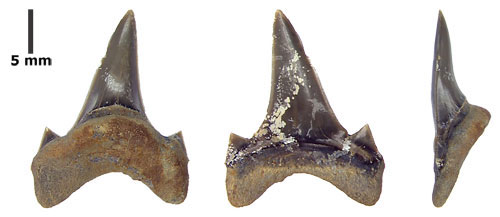 Dwardius siversoni
Dwardius siversoni |
| |
| |
The
Cretoxyrhinidae GLÜCKMAN 1958 sensu SIVERSON (1999)
only include Cretoxyrhina mantelli
(AGASSIZ, 1843), ranging from late Albian to early Campanian.
This species’ dentition has only three upper and lower anterior
teeth. For a good description and figuration, see WELTON &
FARISH (1993), SHIMADA (1997) and the elasmo.com/Cretoxyrhina
genus page. |
| |
During
the latest Albian to middle Turonian interval, Cretoxyrhina
and Cardabiodon were in
the process of loosing the cusplets on their teeth, starting in
the anterior files. This process was well under way by the latest
Albian in Cretoxyrhina and
by the middle Cenomanian in Cardabiodon.
In early populations of Cretoxyrhina
(Albian-Cenomanian), cusplets may be present on lateral and posterior
teeth, while the cusplets become reduced in lateral files in later
populations (Turonian-Campanian). |
| |
|
| |
| |
Cretalamna
GLICKMAN 1958 |
Latest Albian to Early Eocene (CAPPETTA, 1987) |
|
Glickman’s (1958) original spelling of the taxon was Cretalamna,
being repeatedly misspelled as Cretolamna in the subsequent
literature (see SIVERSON, 1999; SHIMADA, 2007). |
HERMAN
(1977: 214) recognised three varieties of Cretalamna:
Cretalamna
appendiculata var. appendiculata
[Cenomanian-Late Campanian]; cusplets large and erect on lateral
teeth, but reduced and slightly diverging on anterior teeth.
Cretalamna
appendiculata var. lata
[Late Campanian-Late Maastrichtian]; a very typical morphology
with anterior teeth that display a wide and low cusp.
Cretalamna
appendiculata var. pachyrhiza
[Late Campanian- Early
Palaeocene]; acquiring a more massive root, this form is close
to Otodus. Lateral teeth of this variety have large and
strongly diverging cusplets. |
| |
|
| |
| |
Archaeolamna
SIVERSON, 1992 |
Globally, the dentition of Archaeolamna resembles that
of odontaspidids, but the lack of a nutrient groove demonstrates
its lamnid affinity (SIVERSON, 1992: 530). The dental formula
differs from that of all other known Cretaceous lamniforms in
possessing lower symphyseal, upper symphyseal and intermediate
teeth, associated with three large upper anterior teeth (UNDERWOOD
& CUMBAA, 2010). The
most distal lateroposterior teeth are much reduced in size and
exhibit strong labial folds on the crown. Anterior and lateroposterior
teeth of this species have well-developed cusplets during its
entire temporal range (Albian-Maastrichtian), which are well-separated
from the base of the cusp.
|
| |
|
| |
| |
Cretodus
SOKOLOV 1965 |
|
Cretodus
semiplicatus (Münster in Agassiz, 1843) - Albian
to Cenomanian
Cretodus crassidens (Dixon, 1850) - Turonian |
| |
The
evolution of this genus involves a decrease in the lingual folds
and a tendency to lose the cusplets (CAPPETTA, 1987). SCHWIMMER
ET AL. (2002) suggest that crassidens is conspecific
with semiplicatus. |
| |
|
| |
|
The
presence or absence of symphyseal teeth
is important for grouping fossil lamniform genera into
families. Symphyseal teeth, small teeth formed on the symphyseal
bars and in the groove between the bars (sensu SIVERSON
1999), are only present in Cretoxyrhina, Cretalamna, Cardabiodon,
Archaeolamna and possibly Dwardius (SIVERSON,
1999; SHIMADA, 2007; UNDERWOOD & CUMBAA, 2010).
|
| |
|
|
| |
Examining associated dentitions, SIVERSON (1999) observed a single
file of upper symphyseal teeth in Cardabiodon, while
Cretoxyrhina possesses multiple files of upper symphyseals
(SHIMADA, 1997; SIVERSON, 1999). SHIMADA (2007) observed 2 files
of upper symphyseal teeth in Cretalamna.
Besides the size, symphyseal teeth of Cretalamna and
Cretoxyrhina are very similar, but those of Cretoxyrhina
exhibit a labial overhang of the root by the crown (SIVERSON,
1992). |
| |
| ______________________________ |
BIDDLE,
J.-P., 1993.
Les Elasmobranches de l’Albien inférieur et moyen
(Crétacé inférieur) de la Marne et de la
Haute-Marne (France). In: Herman, J. & Van Waes,
H. (eds), Elasmobranches et Stratigraphie. Service Géologique
de Belgique, Professional Paper, 264: 191-239.
HERMAN,
J., 1977. Les Sélaciens
des terrains néocrétacés & paléocènes
de Belgique & des contrées limitrophes. Eléments
d'une biostratigraphie intercontinentale. Toelicht. Verhand.
Geologische en Mijnkaarten van België, n°15, 450
pp.
KRIWET, J., KLUG, S., CANUDO, J.I. &
CUENCA-BESCOS, G., 2008. A new Early
Cretaceous lamniform shark: Eoptolamna eccentrolopha
gen. et sp. nov. (Chondrichthyes, Neoselachii). Zoological
Journal of the Linnean Society, 154: 278-290.
SHIMADA, K.,
1997. Dentition of the Late Cretaceous
lamniform shark, Cretoxyrhina mantelli, from the Niobrara
Chalk of Kansas. Journal of Vertebrate Paleontology,
17(2): 269-279.
SHIMADA, K., 2007.
Skeletal and dental anatomy of lamniform shark, Cretalamna
appendiculata, from Upper Cretaceous Niobrara Chalk of Kansas.
Journal of Vertebrate Paleontology 27(3): 584–602.
SIVERSON, M., 1992. Biology,
dental morphology and taxonomy of lamniform sharks from the Campanian
of Kristianstad Basin, Sweden. Palaeontology 35(3): 519-554.
SIVERSON,
M., 1996. Lamniform sharks of the mid Cretaceous Alinga
Formation and Beedagong Claystone, Western Australia. Palaeontology
39(4): 813-849.
SIVERSON,
M., 1999.
A new large lamniform shark from the uppermost Gearle Siltstone
(Cenomanian, Late Cretaceous) of Western Australia. Transactions
of the Royal Society of Edinburgh: Earth Sciences, 90: 49-66.
SIVERSON,
M. & LINDGREN, J., 2005. Late Cretaceous sharks Cretoxyrhina
and Cardabiodon from Montana, USA. Acta Palaeontologica
Polonica, 50(2): 301-314.
SIVERSON,
M., LINDGREN, J., NEWBREY, M.G., CEDERSTRÖM, P. & COOK,
T.D., 2013. Late Cretaceous (Cenomanian-Campanian)
mid-palaeolatitude sharks of Cretalamna appendiculata
type. Acta Palaeontologica Polonica, XX (X): xxx-xxx
SCHWIMMER,
D.R., HOOKS, G.E. & JOHNSON, B., 2002. Revised taxonomy,
age, and geographic range of the large lamniform shark Cretodus
semiplicatus. Journal of Vertebrate Paleontology,
22(3): 704-707.
UNDERWOOD, C.J., 2006. Diversification
of the Neoselachii (Chondrichthyes) during the Jurassic and Cretaceous.
Palaeobiology, 32(2): 215-235.
UNDERWOOD,
C.J. & CUMBAA, S.L., 2010. Chondrichthyans from a Cenomanian
(Late Cretaceous) bonebed, Saskatchewan, Canada. Palaeontology,
53(4): 903-944.
WELTON,
B. & FARISH, R., 1993. The collector’s guide
to fossil sharks and rays from the Cretaceous of Texas. Before
Time, Texas, 204 pp.
WOODWARD, A.S., 1902-1912.
The Fossil Fishes of the English Chalk.
Palaeontographical Society, London. 264 pp.
|
| |
| |
| |
|
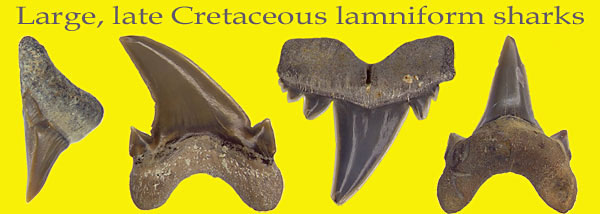
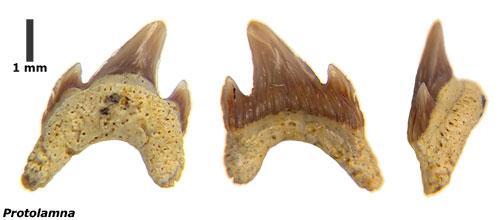
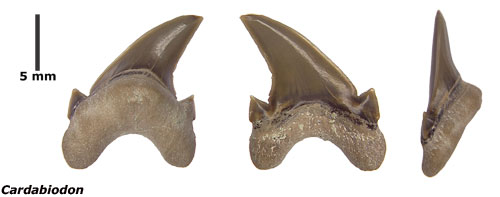
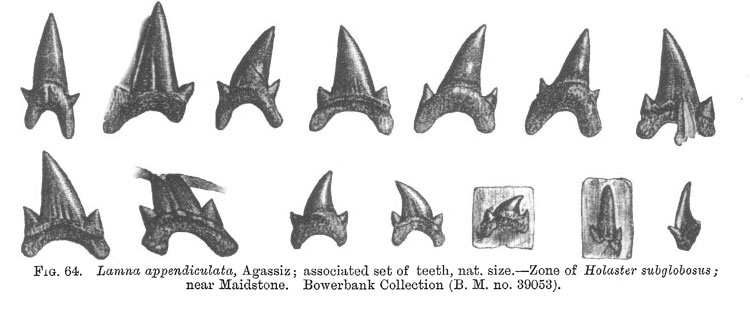
 Dwardius siversoni
Dwardius siversoni
